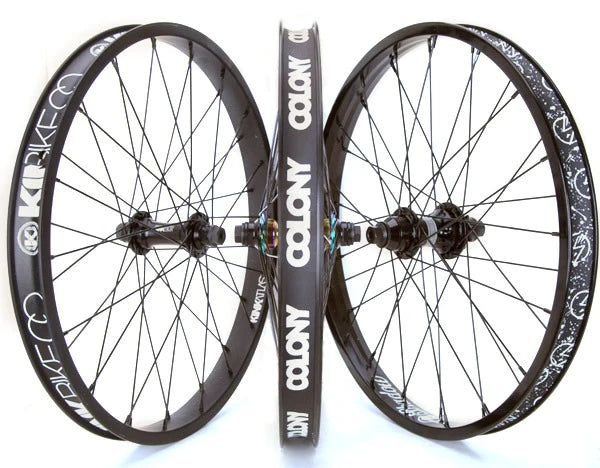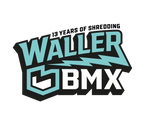Wheels Explained
Waller BMX - Wheels Explained
BMX Wheels can be confusing as you need to consider many things to ensure the fit is correct for your bike such as drive-side, driver size, axle size and whether or not you’re going to run cassette or freecoaster. Quality varies too and of course don’t forget you can custom build your own wheels with us for free - the decisions!

Complete Wheels - These come pre-built and usually with a 9 tooth driver unless otherwise specified. You’ll need to know whether to buy Right Hand Drive (RHD) or Left Hand Drive (LHD) to match your current setup.
Hubs - There’s many hubs to choose from and many differences between them all. Some hubs have almost instant engagement such as Profile Elite hubs which can be great for race starts on a gate. Others like freecoaster have lots of ‘slack’ - this means engagement isn’t instant. Again, you’ll need to take note of your current setup as this could be RHD or LHD.
Rims - The main difference between lower and higher end rims is the wall strength and construction of the rim. For example, a single wall rim is much more likely to bend than a double wall rim. G-sport pioneered the rim by introducing the G-sport Ribcage rim which is reinforced with a patented rib like structure dramatically improving strength. BMX rims are measured in Effective Rim Diameter (ERD).
Spokes - Spokes come in a number of lengths to suit different hub flange sizes and ERD sizes of rim. You can usually choose between regular 14G spokes or 14G double-butted (DB) spokes. A DB spoke is slightly thicker at the top of bottom of the spoke where it’s prone to snapping.
Cassette or Freecoaster - This is purely personal preference as it depends on your style of riding and the tricks you do. For example, if you go backwards a lot of do fakie tricks a freecoaster hub may compliment your riding but, if you ride trails or dirt jumps mostly then a cassette hub with quicker engagement would feel much better.
Driver sizes - There is a standard for gearing in BMX which goes a little like the following; 23T-8T, 25-9T, 28T-10T, 30T-11T. You can of course slightly change this which will either make the gearing easier or harder depending on how you change it. When making the front sprocket smaller this makes the gearing easier and quicker to accelerate. When making the rear driver bigger this makes the gearing harder or slower to accelerate.
Male or Female axles - Male axles were most common in the early days of BMX. Since then many brands have started to use female axles in their hubs. The reason for this is that once you bend a male axle that’s it - it needs replacing. At least with a female axle and bolts if you bend or snap a bolt you can simply replace it which is great with the peg abuse most hubs receive today.
Hubguards (HG) - When purchasing a HG some fit directly onto the hub and replace the cone nut whereas some actually slide onto the axle sitting up against the cone nut. Using these types of HG spread the frame which can put pressure on certain points of the frame. Some brands manufacture HG’s that attach to the spokes whilst protecting the hub and spokes like G-sport.
36H or 48H - Most hubs now are 36 hole rather than 48. Reason being is they are much lighter and use less spokes. However, as a 48H hub would have more cross patterns and spokes in theory it is stronger than a 36H setup.
Building Wheels - This can be quite complicated but only when you’re learning, after a few wheel builds it becomes more like second nature. When building your own custom wheel you need to be 100% sure the spokes are the correct size (mm). To help with this we’ve integrated our own Spoke Calculator into our website.
Hubs - There’s many hubs to choose from and many differences between them all. Some hubs have almost instant engagement such as Profile Elite hubs which can be great for race starts on a gate. Others like freecoaster have lots of ‘slack’ - this means engagement isn’t instant. Again, you’ll need to take note of your current setup as this could be RHD or LHD.
Rims - The main difference between lower and higher end rims is the wall strength and construction of the rim. For example, a single wall rim is much more likely to bend than a double wall rim. G-sport pioneered the rim by introducing the G-sport Ribcage rim which is reinforced with a patented rib like structure dramatically improving strength. BMX rims are measured in Effective Rim Diameter (ERD).
Spokes - Spokes come in a number of lengths to suit different hub flange sizes and ERD sizes of rim. You can usually choose between regular 14G spokes or 14G double-butted (DB) spokes. A DB spoke is slightly thicker at the top of bottom of the spoke where it’s prone to snapping.
Cassette or Freecoaster - This is purely personal preference as it depends on your style of riding and the tricks you do. For example, if you go backwards a lot of do fakie tricks a freecoaster hub may compliment your riding but, if you ride trails or dirt jumps mostly then a cassette hub with quicker engagement would feel much better.
Driver sizes - There is a standard for gearing in BMX which goes a little like the following; 23T-8T, 25-9T, 28T-10T, 30T-11T. You can of course slightly change this which will either make the gearing easier or harder depending on how you change it. When making the front sprocket smaller this makes the gearing easier and quicker to accelerate. When making the rear driver bigger this makes the gearing harder or slower to accelerate.
Male or Female axles - Male axles were most common in the early days of BMX. Since then many brands have started to use female axles in their hubs. The reason for this is that once you bend a male axle that’s it - it needs replacing. At least with a female axle and bolts if you bend or snap a bolt you can simply replace it which is great with the peg abuse most hubs receive today.
Hubguards (HG) - When purchasing a HG some fit directly onto the hub and replace the cone nut whereas some actually slide onto the axle sitting up against the cone nut. Using these types of HG spread the frame which can put pressure on certain points of the frame. Some brands manufacture HG’s that attach to the spokes whilst protecting the hub and spokes like G-sport.
36H or 48H - Most hubs now are 36 hole rather than 48. Reason being is they are much lighter and use less spokes. However, as a 48H hub would have more cross patterns and spokes in theory it is stronger than a 36H setup.
Building Wheels - This can be quite complicated but only when you’re learning, after a few wheel builds it becomes more like second nature. When building your own custom wheel you need to be 100% sure the spokes are the correct size (mm). To help with this we’ve integrated our own Spoke Calculator into our website.
